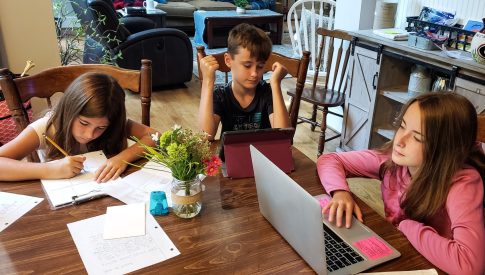Biology - Higher Index
Online Lessons for Students in Scotland learning Higher Biology
- The Structure and Organisation of DNA
- Replication of DNA
- Polymerase chain reaction (PCR)
- Gene expression
- Cellular differentiation
- The structure of the Genome
- Mutations
- Evolution
- Genomic Sequencing
- Metabolic pathways
- Control of metabolic pathways
- Cell respiration
- Metabolic rate
- Metabolism in conformers and regulators
- Metabolism and adverse conditions
- Environmental control of metabolism
- Genetic control of metabolism
- Food supply, plant growth and productivity
- Photosynthesis
- Plant and animal breeding
- Crop protection
- Animal welfare
- Symbiosis
- Social Behaviour
- Biodiversity
The structure and organisation of DNA: DNA is present in the cells of every living thing. However, the DNA is organised differently in different types of organism. We can divide cells into two groups based on how they organise their DNA – eukaryotes and prokaryotes. Prokaryotes bacteria are prokaryotes. They do not have a membrane-bound nucleus and their DNA is free in the cytoplasm. Animals, plants and fungi are eukaryotes. They have a membrane-bound nucleus and their chromosomes are linear rather than circular.DNA and the genome: DNA is the molecule that is the hereditary material in all living cells. Genes are made of DNA, and so is the genome itself. A gene consists of enough DNA to code for one protein, and a genome is simply the sum total of an organism’s DNA.
Introduction to DNA, nucleotides and organisation of DNA: pupils learn to understand and describe the structure of DNA and its formation, describe the make up of nucleotides and state the different structures of DNA and the organisms that have these.
Replication: DNA replication is the process by which a double-stranded DNA molecule is copied to produce two identical DNA molecules.
Copying of genetic code and the process of DNA replication: the genetic code is universal because it is the same among all organisms. Replication is the process of copying a molecule of DNA. Transcription is the process of converting a specific sequence of DNA into RNA.
Polymerase Chain Reaction (PCR): a laboratory technique used to amplify DNA sequences. The method involves using short DNA sequences called primers to select the portion of the genome to be amplified.
The process of PCR and its applications: PCR relies on a thermostable DNA polymerase, taq polymerase, and requires DNA primers designed specifically for the DNA region of interest. In PCR, the reaction is repeatedly cycled through a series of temperature changes, which allows many copies of the target region to be produced.
Gene expression: the process by which information from a gene is used in the synthesis of a functional gene product that enables it to produce end products, protein or non-coding RNA, and ultimately affect a phenotype, as the final effect.
Genes, protein synthesis and RNA: pupils to know terms like phenotype and genotype, to describe the structure of the gene, understand the differences between DNA and RNA and describe the types of RNA structure.
Genetic code, transcription, splicing, translation and alternative RNA Splicing: earn to describe the process of transcription when looking at gene expression, to be able to describe the process of splicing, describe the process of translation when looking at gene expression and alternative splicing processes.
Cellular differentiation: the process by which a cell changes from one cell type to another. Usually, the cell changes to a more specialised type. Differentiation occurs numerous times during the development of a multicellular organism as it changes from a simple zygote to a complex system of tissues and cell types.
Cellular differentiation and stem cells: the lesson describes the process of cellular differentiation, both in animal and plant cells. To remember and describe stem cells in animals and to describe meristems in plants.
Applications of stem cells and the ethical implications: the lesson describes the use of stem cells in scientific research. It describes the therapeutic uses of stem cells in medicine. Learn to understand and discuss the ethical implications of the use of stem cells.
The structure of the genome: coding and non-coding sequences. A genome is made up of genes and other DNA sequences that do not code for proteins.
Genome and genetic structure: pupils learn to describe the key components of the genome, the function of coding sequences and non-coding sequences.
Mutations: a mutation is a change in a DNA sequence. Mutations can result from DNA copying mistakes made during cell division, exposure to ionising radiation, exposure to chemicals called mutagens, or infection by viruses.
Single-gene mutations and substitution mutations: when a cell divides, the process of DNA replication is very carefully controlled to preserve the genetic information encoded within the nucleotide base sequence. Single-gene mutations involve the alteration of a DNA nucleotide. This can happen as a result of one of the following: the substitution of one nucleotide with another the insertion of one or more nucleotides into a DNA sequence the deletion of one or more nucleotides from a sequence.
Chromosome structure mutations: alterations that affect whole chromosomes and whole genes rather than just individual nucleotides. These mutations result from errors in cell division that cause a section of a chromosome to break off, be duplicated or move onto another chromosome.
Mutations and the link to evolution: Gene duplication is very important for the evolution of species because it can facilitate the creation of new genes. Normally, changes to genes result in loss of function and so are weeded out by natural selection.
Evolution: in biology, evolution is the change in the characteristics of a species over several generations and relies on the process of natural selection.
Evolution and gene transfer: this lesson describes evolution as a process, the concept of gene transfer, process of vertical gene transfer, the process of horizontal gene transfer.
Selection and speciation: speciation is an evolutionary process by which a new species comes into being. Natural selection can result in organisms that are more likely to survive and reproduce and may eventually lead to speciation.
Genomic sequencing: whole-genome sequencing is the process of determining the entirety, or nearly the entirety, of the DNA sequence of an organism’s genome at a single time.
Genomic sequencing and genome comparison: comparative genomics is a field of biological research in which the genomic features of different organisms are compared.
Phylogenetics and molecular clocks: the molecular clock is a figurative term for a technique that uses the mutation rate of biomolecules to deduce the time in prehistory.Personal genomics, health and pharmacogenetics: medical researchers may use genomic information to compare the DNA of individuals who bear an inherited disease with those who are unaffected. Differences between their genomes may reveal the precise mutation and cause of their condition. It is also possible to identify variations in a person’s genome that predict how well that person will respond to certain drugs. The study of this is called pharmacogenetics.
Metabolism and survival: the lessons in this section include metabolic pathways, membrane transport, cell respiration, metabolic rate and more.
Metabolic pathways: a linked series of chemical reactions occurring within a cell. The reactants, products, and intermediates of an enzymatic reaction are known as metabolites, which are modified by a sequence of chemical reactions catalysed by enzymes.
Metabolic pathways and membrane transport: in cellular biology, membrane transport refers to the collection of mechanisms that regulate the passage of solutes such as ions and small molecules through biological membranes.
Control of metabolic pathways: regulation of metabolic pathways includes regulation of an enzyme in a pathway by increasing or decreasing its response to signals. Control involves monitoring the effects that these changes in an enzyme’s activity have on the overall rate of the pathway.
Control of metabolic pathways and enzymes: enzymes are proteins that act as biological catalysts. Catalysts accelerate chemical reactions. The molecules upon which enzymes may act are called substrates and the enzyme converts the substrates into different molecules known as products.
Cell respiration: cellular respiration is a set of metabolic reactions and processes that take place in the cells of organisms to convert chemical energy from oxygen molecules or nutrients into adenosine triphosphate and then release waste products.
Respiration, ATP and phosphorylation: phosphorylation of a molecule is the attachment of a phosphoryl group. This process and its inverse, dephosphorylation, are critical for many cellular processes in biology.
Glycolosis, citric acid cycle, electron transport chain and fermentation: lesson teaches the main stages of cellular respiration, biochemistry occurring in the different stages and what is meant by the term respiration and fermentation.
Metabolic rate: an organism’s metabolic rate is the amount of energy expended by that organism in a given time period – usually daily. At rest, meaning in periods of inactivity, the metabolic rate is known as the basal metabolic rate (BMR).
Metabolic rate, oxygen transport and comparative anatomy and physiology: the lesson teaches the different methods of measuring metabolic rates, how rates can be measured between animals. It explains the need for oxygen when looking at high metabolic rates and how to apply knowledge to compare animal physiology.
Metabolism in conformers and regulators: he maintenance of an organism’s metabolic rate is affected by abiotic factors such as temperature, pH and salinity. Organisms can be categorised into two broad groups – conformers and regulators. conformers – dependent upon the changes in the external environment regulators – can control their internal environment regardless of external environmental change.
Abiotic factors, conformers and regulators: abiotic components or abiotic factors are non-living chemical and physical parts of the environment that affect living organisms and the functioning of ecosystems.
Homeostasis, negative feedback and thermoregulation: homeostasis is the state of steady internal, physical, and chemical conditions maintained by living systems. Thermoregulation is the ability of an organism to keep its body temperature within certain boundaries, even when the surrounding temperature is very different.
Metabolism and adverse conditions: any environmental conditions, such as temperature, go beyond those that an organism is able to withstand and would halt normal metabolic activity.
Surviving adverse conditions, dormancy, hibernation, aestivation and torpor: the lesson teaches how animals survive adverse conditions, benefits of dormancy, categories of dormancy based on environmental conditions, teaches and explains the types of dormancy used by animals to survive.
Migration, migratory studies and migratory behaviours: migratory behaviour is persistent and straightened out movement effected by the animal’s own locomotory exertions or by its active embarkation upon a vehicle. It depends on some temporary inhibition of station keeping responses but promotes their eventual disinhibition and recurrence.
Environmental control of metabolism: learn to state that the growth of microorganisms is influenced by the composition of the growth medium and environmental conditions. Learn to state that microorganisms require an energy source (chemical or light) and simple chemical compounds for biosynthesis.
Microorganisms, growth media, environmental controls: An Environmental Control (EC) system can provide a level of independent control of many devices in the home for people with significant physical disabilities.
Phases of growth and exponential growth of microorganisms: there are four distinct phases of the growth curve: lag, exponential (log), stationary, and death.
Genetic control of metabolism: metabolism and gene regulation are two fundamental biological processes that are essential to all living organisms.
Mutagenesis, recombinant DNA technology, enzymes, vectors and host cells: this lesson teaches state what a wild strain of microbe is, how these wild strains can be improved, explain use of vectors. We describe safety measures, describe how enzymes are used in genetic engineering, and state the parts of a modified plasmid.
Sustainability and interdependence: lessons include food supply, plant growth and productivity, photosynthesis, plant and animal breeding, crop protection, animal welfare, symbiosis and more.
Food supply, security, production and trophic levels: food security and sustainable food production. The increase in human population and concern for food security leads to a demand for increased food production. Food production must be sustainable and not degrade the natural resources on which agriculture depends. Agricultural production depends on factors that control plant growth.
Photosynthesis: a process used by plants and other organisms to convert light energy into chemical energy that, through cellular respiration, can later be released to fuel the organism’s activities.
Photosynthesis, pigments, absorption and action spectra: the action spectrum shows the rate of photosynthesis at different wavelengths. The absorption spectrum shows how strongly the pigments absorb at different wavelengths. Green is not strongly absorbed; rather it is reflected, causing leaves to look green.
Photosynthesis processes: plants are autotrophs, which means they produce their own food. They use the process of photosynthesis to transform water, sunlight, and carbon dioxide into oxygen, and simple sugars that the plant uses as fuel. These primary producers form the base of an ecosystem and fuel the next trophic levels.
Plant and animal breeding: scientists and farmers have manipulated the DNA of crops and animals by selective breeding for centuries. This has been used to improve certain characteristics for example: higher food yields, higher nutritional values, pest and disease resistance and the ability to thrive in particular environmental conditions.
Breeding, genetics and field trials: breeding is sexual reproduction that produces offspring, usually animals or plants.
Selecting and breeding, inbreeding depression, cross breeding and gene technology: Over many years farmers and breeders have selected the plants and animals with the best characteristics to be the parents of the next generations. This allows them to bring together the desired alleles of two organisms thereby producing offspring superior to the parents.
Crop protection: the science and practice of managing plant diseases, weeds and other pests that damage agricultural crops and forestry. Agricultural crops include field crops, vegetable crops and fruits.
Monoculture, weeds, pests and diseases: Monoculture is the practice of growing one crop species in a field at a time. Monoculture is widely used in intensive farming and in organic farming.
Pest control, artificial means, biological means and integrated pest management: Integrated pest management, or IPM, is a process you can use to solve pest problems while minimising risks to people and the environment.
Animal welfare: the well-being of non-human animals. Formal standards of animal welfare vary between contexts, but are debated mostly by animal welfare groups, legislators, and academics.
Animal welfare and behavioural indicators: animal welfare is the well-being of non-human animals. Formal standards of animal welfare vary between contexts, but are debated mostly by animal welfare groups, legislators, and academics.
Symbiosis: any type of a close and long-term biological interaction between two different biological organisms, be it mutualistic, commensalistic, or parasitic. The organisms, each termed a symbiont, must be of different species.
Symbiosis, parasitism and mutualism: mutualism is the interaction between two or more organisms where both organisms can benefit from the interaction. Parasitism is the interaction between two species where only one benefits from the other organism and the other is harmed in return.
Social behaviour: Social behaviour is behaviour among two or more organisms within the same species, and encompasses any behaviour in which one member affects the other. This is due to an interaction among those members.Social groups and hierarchy, co-operative hunting and social defence: many animals live in social groups. Individuals benefit from increased survival due to increased protection and the opportunities for cooperative hunting.
Biodiversity: the biological variety and variability of life on Earth. Biodiversity is a measure of variation at the genetic, species, and ecosystem level.
Altruism and kin selection, group interactions and behaviours: kin-selection theory predicts that animals are more likely to behave altruistically towards their relatives than towards unrelated members of their species.
Measuring biodiversity, threats to biodiversity and introduced, naturalised and invasive species:There are three measurable components of biodiversity: genetic diversity; species diversity; ecosystem diversity.


"It's bright and colourful, easy to read, and extremely easy to use unlike most textbooks or online learning websites" Daisy, S3 PupilSign Up & Learn Today

